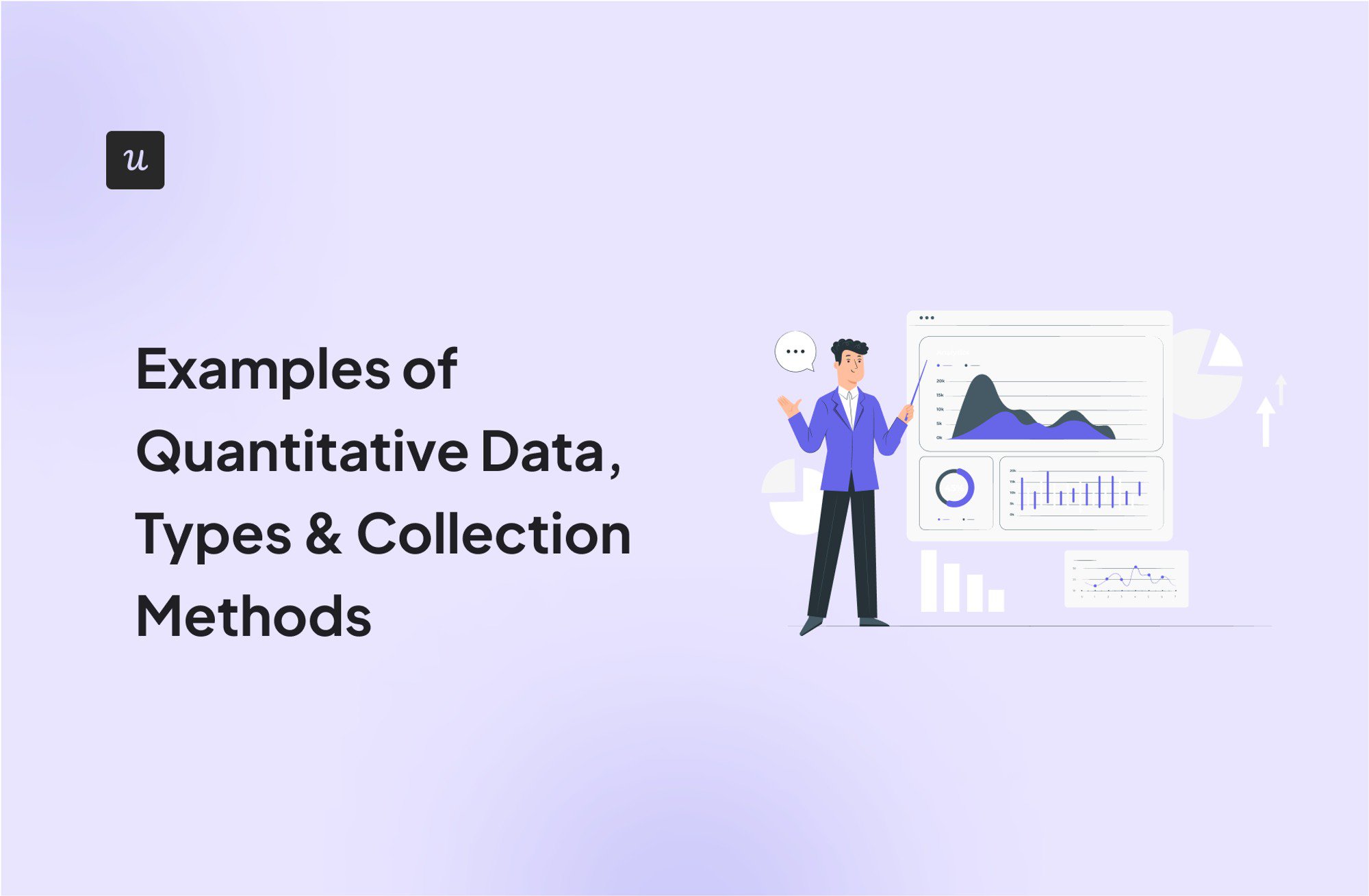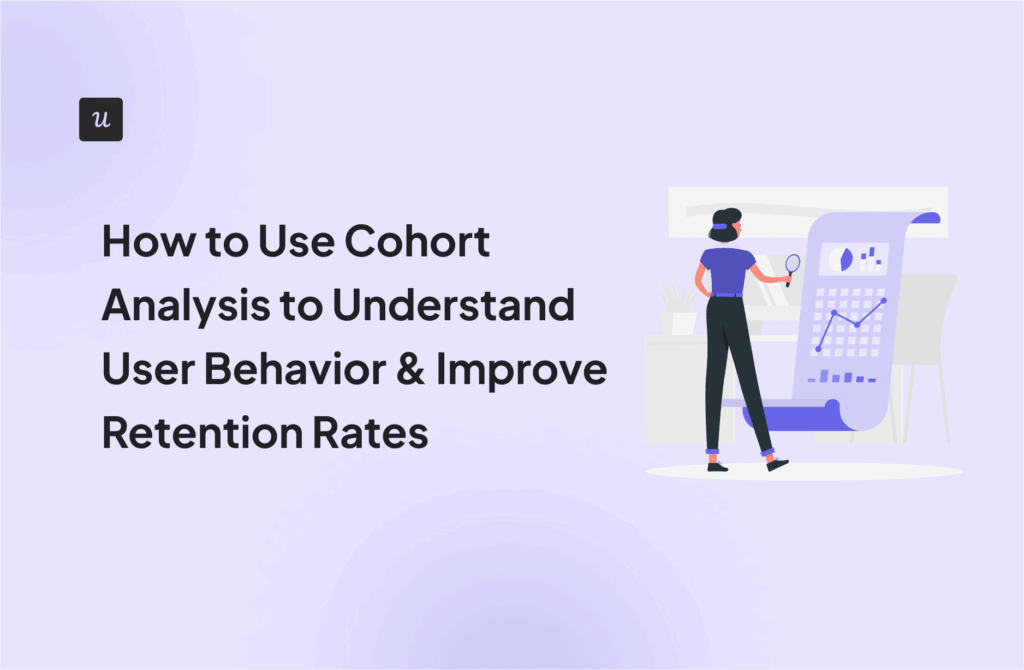
Try Userpilot Now
See Why 1,000+ Teams Choose Userpilot

What is quantitative data?
Quantitative data refers to numerical data that can be measured, such as adoption rates, number of users, or net promoter scores.
Collecting this data is useful because it provides objective and measurable insights that you can analyze statistically and benchmark, minimizing subjective interpretation and bias.
The difference between quantitative and qualitative data
Quantitative data refers to information that can be measured and expressed numerically, allowing for objective analysis. It answers the questions such as “what” and “how many.”
In contrast, qualitative data involves non-numerical information, such as opinions, behaviors, and experiences. You typically gather this through interviews, observations, or open-ended surveys to understand “why” and “how.”
While quantitative data provides measurable and comparable results, qualitative data offers deeper insights into the underlying reasons, opinions, and motivations behind those numbers.
Together, quantitative data and qualitative data offer a comprehensive understanding of user behavior and decision-making processes.
High-level types of quantitative data
You can categorize quantitative data into several high-level types, each crucial to data-driven analysis methods.
Discrete data
Discrete data is a type of quantitative data that comprises specific and countable numerical values that cannot be subdivided meaningfully. For example, discrete data could be the number of customer support tickets that are counted individually—you cannot have 2.5 support tickets.
Continuous data
Continuous data is a type of quantitative data that represents measurements that can take any numerical value within a range. For example, you can measure time-to-value in minutes and seconds and divide it into smaller increments, such as 5 minutes and 34 seconds, 5 minutes and 35 seconds, etc.
Interval data
Interval data is numerical data where the differences between values are meaningful, but there is no true zero point. A typical example is the temperature, where you can measure the difference between numerical values, but 0°C does not mean the absence of temperature.
Ratio data
Ratio data is quantitative data that allows for meaningful differences and ratios between numerical values, with a true zero point showing the absence of the measured quantity. An example of ratio data is MRR, where $0 MRR indicates no recurring revenue, and you can compare it meaningfully, such as saying one company has twice the MRR of another.
SaaS examples of quantitative data to track
Here are some SaaS examples of quantitative data that PLG companies should track.
User activation rate
User activation rate is quantitative data that measures the percentage of users who complete a key action that signifies they are gaining value from the product. It helps you understand how your onboarding process converts new users into active, engaged customers.
You can calculate this metric with the following formula:
User Activation Rate = (Number of Activated Users / Total Number of Sign-Ups) × 100.
According to our metrics report, the average user activation rate is 37.5%.

Time to value
Time to Value (TTV) is a type of quantitative data that measures the time it takes for a new user to realize the value of your product. This metric helps you understand whether your onboarding process effectively guides users to that “Aha” moment.
You can calculate this product metric as the time elapsed between the user’s initial sign-up and the “Aha” moment.
The average TTV across different industries based on our first-party data is one day, 12 hours, and 23 minutes.

Onboarding checklist completion rate
Among examples of quantitative data, the onboarding checklist completion rate measures the percentage of users who complete all the tasks in your onboarding checklist. This rate is a key indicator of how effectively your user onboarding process guides new users through the essential steps.
You can calculate this metric using the following formula:
Onboarding Checklist Completion Rate = (Number of Users Who Completed the Checklist / Total Number of Users Who Started the Checklist) × 100
According to our report, the average checklist completion rate is 19%.

The core feature adoption rate
The core feature adoption rate is quantitative data that measures the percentage of users who adopt and regularly use your product’s most essential features.
This metric shows how well users integrate your product’s key functionalities into their workflows, which can directly affect customer retention and satisfaction.
You can calculate this metric with the following formula:
Core Feature Adoption Rate = (Number of Monthly Active Users / Total Number of User Logins) × 100
Based on our findings, the average core feature adoption rate is 24.5%.

1-month retention rate
The 1-month retention rate is quantitative data that measures the percentage of users who continue to use your product one month after signing up. This metric shows how well your product meets user needs and keeps them engaged over the critical initial period.
To calculate the 1-month retention rate, you can use the following formula:
1-Month Retention Rate = (Number of Users Who Remain Active After 1 Month / Total Number of Users at the Start of the Month) × 100
Our data shows that the average 1-month retention rate is 46.9%.

Customer churn rate
Customer churn rate is quantitative data that measures the percentage of customers who stop using your product or service within a specific period.
This metric is crucial for understanding customer satisfaction and the overall health of your business because a high churn rate can show underlying issues with product value, user experience, or customer support.
To calculate the customer churn rate, you can use the following formula:

If you started the month with 1,000 customers and 50 customers churned by the end of the month, your churn rate would be as follows:
(50 / 1,000) × 100 = 5%
User stickiness
User stickiness is quantitative data that measures how often users return to your product within a specific period. This metric is a key indicator of user engagement and loyalty, showing how well your product keeps users returning regularly.
High customer stickiness typically means your product is valuable and engaging enough to become a regular part of users’ routines.
You can use the following formula to calculate stickiness:

If your product has 5,000 Daily Active Users (DAU) and 20,000 Monthly Active Users (MAU), the stickiness expressed in percentage would be:
(5,000 / 20,000) × 100 = 25%
Net Promoter Score (NPS)
Net Promoter Score (NPS) is quantitative data that measures customer loyalty and satisfaction by asking users how likely they are to recommend your product or service to others. NPS helps you understand the overall perception of your brand and can show areas for improvement in customer experience.
To calculate NPS, ask customers to rate their likelihood of recommending your product on a scale from 0 to 10. Based on their responses, customers are categorized into three groups:
- Promoters (9-10): Loyal customers who will probably recommend your product.
- Passives (7-8): Satisfied but unenthusiastic customers who competitors could sway.
- Detractors (0-6): Unhappy customers who are unlikely to recommend your product and may even discourage others from using it.
You can calculate NPS using the following formula:
(Net Promoter Score) = % of Promoters – % of Detractors
Our report records the average NPS to be 35.7%.

Customer Satisfaction Score (CSAT)
Customer Satisfaction Score (CSAT) measures how satisfied customers are with your product.
To calculate CSAT, you typically ask customers to rate their satisfaction from 1 to 5, with one being very dissatisfied and five being very satisfied. After the quantitative data collection, you count the number of satisfied customers who gave a rating of 4 or 5.
Then, apply this formula to get your CSAT score:

For example, if you surveyed 100 customers and 80 of them gave you a rating of 4 or 5, your CSAT would be:
(80 / 100) × 100 = 80%
Customer Effort Score (CES)
Among quantitative data examples, Customer Effort Score (CES) measures how much effort a customer has to exert to use your product or resolve an issue. CES is critical for understanding how user-friendly your product is.
To calculate this metric, you typically ask customers to rate their agreement with a statement like “The product is easy to use” on a Likert scale, usually ranging from 1 (strongly disagree) to 5 (strongly agree). After collecting responses, you count the number of customers who answered “agree” (4) or “strongly agree” (5).
Then, you can calculate the CES with this formula:

For instance, if you surveyed 100 customers and 70 of them responded with “agree” or “strongly agree,” your CES score would be:
(70 / 100) × 100 = 70%
How to collect quantitative data with Userpilot
Now that you know which examples of quantitative data you should collect, the question is: how? Here are three simple ways to collect quantitative data with product growth tools like Userpilot:
Use the auto-capture functionality to automatically track events
With Userpilot’s auto-capture functionality, you can automatically track quantitative data on clicks, text inputs, and form submissions without manually tagging each interaction.

Using retroactive analysis saves your valuable time and removes the dependencies on engineering as they don’t need to write code. Also, there are no data gaps, and you don’t have to decide which data to track in advance. Pretty neat, huh?
Set up A/B and multivariate testing to collect experiment data
With Userpilot, you can easily set up A/B testing and multivariate testing to collect valuable quantitative data.

For example, you can test different elements, such as onboarding flows, and get data on how different segments interact with them.

Launch surveys to gather NPS, CSAT, and CES scores
You can launch in-app surveys with Userpilot to efficiently gather NPS, CSAT, and CES data. These surveys provide a reliable method for collecting and analyzing quantitative data on user sentiment and overall satisfaction.
Plus, you can enrich these surveys with open-ended questions, allowing you to gather additional qualitative feedback. This combination of quantitative and qualitative data provides a more comprehensive understanding of user experiences and sentiments.

Conclusion
There are many examples of quantitative data, but thankfully there are product analytics tools that make collecting them easier. One of the best ways of achieving this is by automatically capturing key events, which is exactly what Userpilot enables.
If you want to auto-capture key user actions, launch no-code surveys, perform quantitative data analysis, and then create personalized product experiences, book a demo now to see how we can help.







